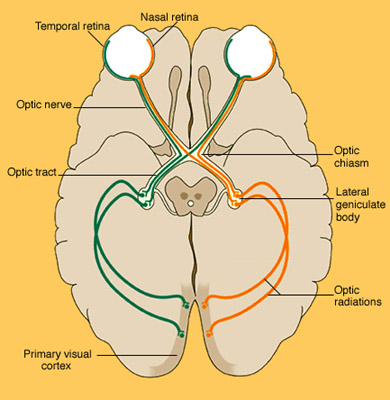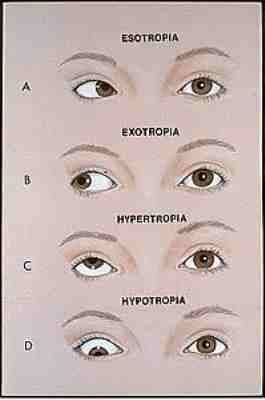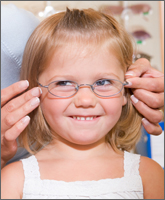Everyone has heard the term “Lazy Eye” but in reality this is not be the best term.
In actuality, it is most often not the eye that is the problem but rather the eye’s connections to the brain and the brains ability to use the eye that is really the issue.
This condition, called Amblyopia occurs in 4-5% of otherwise healthy children and is the main reason that the doctors at Precision Family Eye Care strongly recommend all children receive routine eye care to identify and treat this condition early. Here’s why…
Amyblopia or “Lazy Eye”
As eluded to, amblyopia is most often not a disease of the eye itself, the eye is usually perfectly healthy. However even with the correct glasses prescription in place, the eye does not see things normally and is termed “lazy”.
How can that be??
Well, when a child is born there is no vision in the womb, therefore there is very little vision at birth. Like walking, talking, and crawling, vision is learned. It is only after an infant starts examining the world around it that firm hard wiring begins.
 The eyes are obviously in the front, but they are a camera, nothing more. What actually “sees” is the occipital lobe at the back of the brain. The pictures from the eyes are sent via the optic nerve to the Lateral Geniculate Body (LGN) in brain for processing. After that, the processed signal is sent by optic radiations called the Meyer’s Loops to the Primary Visual Cortex of the occipital lobe which actually interprets the picture (diagram right).
The eyes are obviously in the front, but they are a camera, nothing more. What actually “sees” is the occipital lobe at the back of the brain. The pictures from the eyes are sent via the optic nerve to the Lateral Geniculate Body (LGN) in brain for processing. After that, the processed signal is sent by optic radiations called the Meyer’s Loops to the Primary Visual Cortex of the occipital lobe which actually interprets the picture (diagram right).
Because this complex pathway requires active stimulus or pictures from the eyes to form, this process can be disrupted if there is not a normal picture coming from each eye. This process of abnormal visual development can occur in one or both eyes and for a number of reasons. The most common reasons for Amblyopia are high or asymmetric eye prescriptions and strabismus (eye turns).
If found early, treatment and training is available to help build this nerve network; if not, the vision reduction is permanent.
Types of Amblyopia
Refractive Amblyopia
Refractive amblyopia occurs when there is a large or very unequal refractive error (glasses prescription) present at birth. Even though the eyes are healthy, if one or both eyes are unable to send a clear image to the brain, the brain will not connect to the eyes properly. One of the most common scenarios is when one eye is normal (little or no glasses prescription required) and the other eye is born very farsighted. In this scenario, a child will see clearly with both eyes open and rarely complain of problems because their brain is only paying attention to “the good eye.”
Pediatric Strabmismus (Eye Turn) Amblyopia
 Strabismus is a condition that occurs when the eyes aren’t properly aligned with one another from birth. This results in one eye turning in, out, up or down with respect to the other eye. When the eyes are not working together properly, the brain is getting two different pictures from the eyes. This leads to double vision which the brain does not like. As a result, the brain will then decide to pick only one eye to develop properly and the input from the other turned eye will be ignored.
Strabismus is a condition that occurs when the eyes aren’t properly aligned with one another from birth. This results in one eye turning in, out, up or down with respect to the other eye. When the eyes are not working together properly, the brain is getting two different pictures from the eyes. This leads to double vision which the brain does not like. As a result, the brain will then decide to pick only one eye to develop properly and the input from the other turned eye will be ignored.
Without the input from that eye to develop the needed connections to the brain explained above, the turned eye will have permanently reduced vision if not properly diagnosed and treated. Eye turns can be quite obvious, however, amblyopia can occur from even mild eye misalignment that often goes unnoticed by parents and teachers.
Both of these types of Amblyopia often result in only one eye being affected and both often go unnoticed without a proper eye exam due to one eye developing properly and the child not understanding that only seeing out of one eye isn’t “normal.”
Treatment of Amblyopia
 Regardless of the cause, is important to identify and treat amblyopia as early in life as possible.
Regardless of the cause, is important to identify and treat amblyopia as early in life as possible.
If the development of one or both eyes is stunted, it is not only possible, but probable, that vision will be improved with treatment. The treatment of amblyopia is directed to improve vision by strengthening the brain’s connections to the weaker amblyopic eye. This can be done with a combination of full time glasses, wearing an eye patch, or sometimes eye drops. As the brain pays more attention to the amblyopic eye, the essential connections between the eye and the brain can be improved, resulting in better vision for that eye.
The key to treatment is timing!!
Children posses amazing neuroplasticity or the ability to rework connections within the brain. Just like everything else though, humans get stuck in our ways over time, and our brains are no different. The visual pathway continues developing from birth through age 7 – 8. If treatment is given before this time, the prognosis of vision improvement is very good. After age 8 however, amblyopia may be resistant to treatment as the visual pathway has already completely developed.
The take home message here is that “Lazy Eye “or Amblopia is more of a brain problem than an eye problem. However, this is very treatable, but requires a proper early diagnosis.
Therefore, all children should receive an eye exam by age 3 and then every year as they go through school ages to ensure them the best chance at a lifetime of healthy eyes and excellent vision.
As always, feel free to contact us with any questions or ideas for future topics.
For more information on Amblyopia, vision development in children, and binocular vision problems please visit our website pages or visit the National Eye Institute’s excellent page about this condition.


